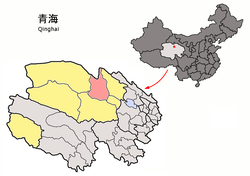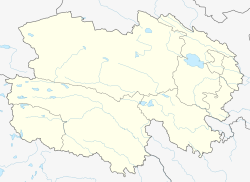Top Qs
Timeline
Chat
Perspective
Delingha
County-level city in Qinghai, China From Wikipedia, the free encyclopedia
Remove ads
Delingha (Chinese: 德令哈; Tibetan: གཏེར་ལིན་ཁ།), or Delhi (Mongolian: ᠳᠡᠯᠡᠬᠡᠢ ᠬᠣᠲᠠ), is the seat of the Haixi Mongol and Tibetan Autonomous Prefecture in northern Qinghai province, China. It is located approximately 200 km (120 mi) southeast of the Da Qaidam Administrative Region. It is a mainly industrial county-level city. The Bayin River divides the city into two parts: Hedong and Hexi. Because the prefecture seat is located in Hedong, it is slightly more flourishing than Hexi, which is chiefly agricultural.[1]
Established in 1988, Delingha administers seven township-level divisions covering an area of 27,700 km2 (10,700 sq mi) and has a total population of 78,184, making it the smallest of the five cities in Qinghai. The name of the city comes from Mongolian and means "golden world" (ᠠᠯᠲᠠᠨ ᠳᠡᠯᠡᠬᠡᠢ),[1] reflecting the relatively large Mongol population of the city. Da Qaidam administrative zone merged into Delingha in mid-2018.
Remove ads
Administrative divisions
Summarize
Perspective
Delingha is divided into 3 subdistricts, 3 towns, and 1 township.
Remove ads
Geography
Summarize
Perspective
Climate
Delingha has a cool semi-arid climate (Köppen BSk) just moist enough to avoid being a cool arid climate (BWk), characterised by warm summers with moderate rainfall and frigid to freezing, dry winters.
Remove ads
Transportation
The Haixi Delingha Airport and Delingha railway station serve the city. The Delingha Tram is under construction.
Economy and industry
Delingha will be home to a 400 million yuan "Mars village" used by the Chinese Academy of Sciences to plan future Mars explorations missions.[6]
At an altitude of 3,000 meters (9,800 ft), a 50 MW concentrated solar power plant with parabolic trough opened in 2018.[7]
References
Wikiwand - on
Seamless Wikipedia browsing. On steroids.
Remove ads



